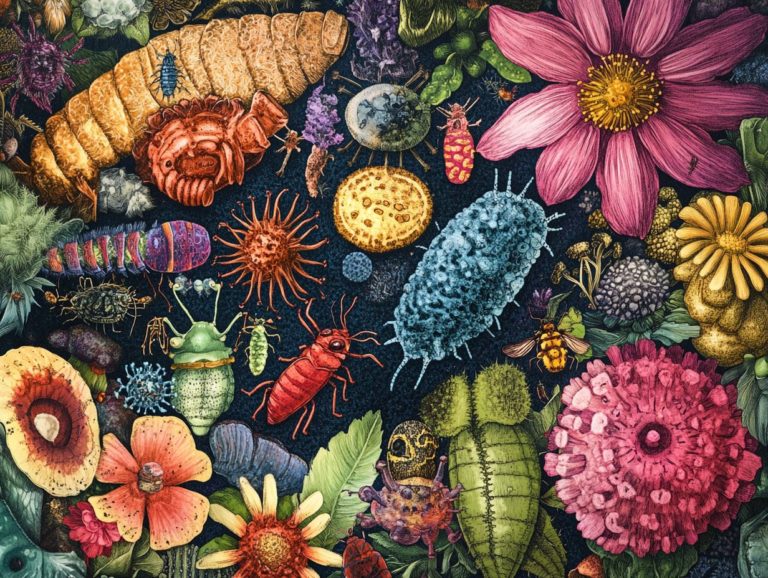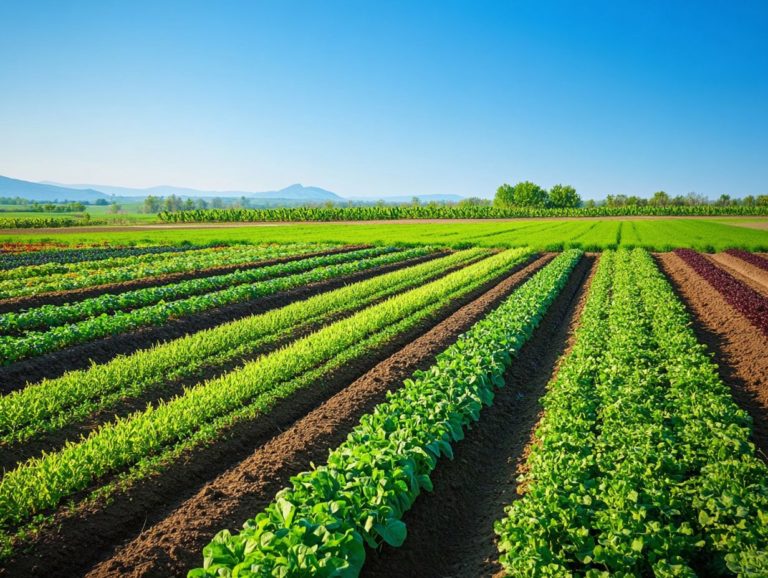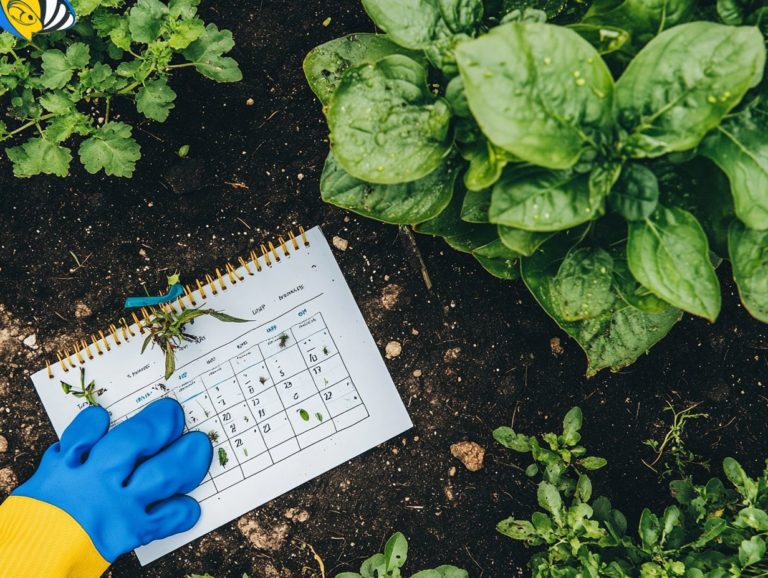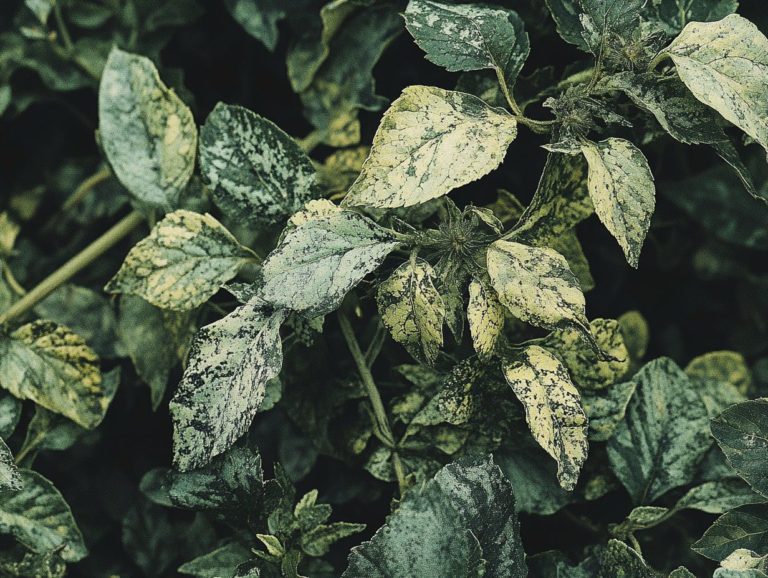The Importance of Monitoring Pests in Your Garden
In any vibrant garden ecosystem, pests play many roles that can greatly influence plant health. Understanding these pest dynamics is essential for maintaining a thriving garden.
This article delves into the signs of pest infestation, guiding you on how to identify common damage and effective monitoring methods, from traditional inspections to cutting-edge technology.
You ll learn why regular pest monitoring is vital for preventing infestations and fostering a healthy environment.
You ll discover practical tips to improve your pest management strategies and keep your garden thriving.
Contents
- Key Takeaways:
- The Role of Pests in Garden Ecosystems
- Signs of Pest Infestation
- Methods for Monitoring Pests
- Benefits of Regular Pest Monitoring
- Tips for Effective Pest Monitoring
- Frequently Asked Questions
- What is the importance of monitoring pests in your garden?
- How can monitoring pests help with early detection?
- What are some common pests that can be found in a garden?
- What are the benefits of using natural methods to control pests in your garden?
- How often should you monitor pests in your garden?
- What are some signs that your garden may have a pest infestation?
Key Takeaways:

The Role of Pests in Garden Ecosystems
Pests hold a pivotal position in garden ecosystems, influencing not just plant health but also the broader ecological equilibrium. To effectively address pest management, especially using natural predators, it’s crucial to grasp their interactions with beneficial insects and other organisms.
The presence of pests can shift pest populations and impact crop health, underscoring the necessity for diligent monitoring and informed management decisions. By doing so, you can mitigate potential pest damage while safeguarding the natural enemies essential for maintaining ecological stability.
Understanding the Impact of Pests on Plants
The impact of pests on your plants can be quite detrimental. Harmful insects can inflict significant damage, affect crop yields, and even pose health concerns for both your plants and the consumers relying on them.
Take aphids, for example; they can swiftly overwhelm your leafy greens, siphoning off vital nutrients and stunting growth. Meanwhile, caterpillars might wreak havoc on brassicas like cabbage, leaving behind unsightly holes that diminish marketability.
Identifying these pests is absolutely crucial. Use sticky traps and check your plants regularly to catch infestations early before they escalate, contributing to early detection.
Pest pressures can also disrupt your crop rotation practices, as certain pests thrive on specific crops, leading to a damaging cycle that could threaten soil health and overall agricultural productivity. This emphasizes the role of cultural practices in pest management.
Understanding economic thresholds how many pests can be present before action is needed to avoid damage is essential. These thresholds serve as invaluable tools, guiding you in making informed decisions about when to intervene, helping you strike an effective balance between costs and benefits.
Signs of Pest Infestation
Recognizing the signs of a pest infestation is essential for effective pest monitoring. Early detection enables you to prevent substantial pest populations from taking root and wreaking havoc on your crops.
By staying vigilant and attentive, you can safeguard your yield and maintain the health of your agricultural investments while addressing potential pest issues.
Identifying Common Pest Damage
Knowing common pest damage helps you identify problems quickly and plays a key role in selecting the right monitoring strategies to mitigate the impact of those pesky insects, as well as understanding their life cycles.
You ll notice that different types of pest damage can show up in various forms, like leaf discoloration, holes in foliage, or even wilting and stunted growth. These signs often point to specific culprits, such as aphids or caterpillars. By recognizing these symptoms, you can pinpoint which pests are wreaking havoc on your plants and tailor your management strategies accordingly.
Regularly monitoring your plants not only aids in early detection but also helps you evaluate how well your control methods are working.
Taking this proactive approach can significantly minimize crop loss and ensure that your plants remain healthy and robust in the long run, fostering a balanced ecosystem.
Take charge of your garden today by implementing these pest monitoring strategies!
Methods for Monitoring Pests

Effective methods for monitoring pests are crucial for managing pest populations. By employing techniques like physical inspections and insect traps, you can gather vital data on pest activity that enables your gardening or farming efforts.
This approach helps you stay one step ahead. It allows you to make informed decisions for optimal pest management, especially through nonchemical methods.
Physical Inspections and Traps
Physical inspections and the strategic use of insect traps are essential for effective pest monitoring. By closely examining your plants for signs of damage or pest presence, you can spot potential issues early and prevent widespread infestations.
Placing insect traps, like sticky traps or pheromone lures, captures unwanted insects and acts as a visual indicator of pest activity. This guides your next steps. These proactive techniques are crucial for maintaining the health of your plants, allowing you to implement targeted responses instead of relying on broad-spectrum chemical treatments.
Embracing these sustainable practices fosters an eco-friendly environment. It also supports beneficial insect populations and promotes the overall vigor of your plants while enhancing ecosystem balance.
Using Technology for Monitoring
Utilizing technology for pest monitoring elevates your decision-making process. It enables you to track pest populations with remarkable accuracy and implement effective control measures based on real-time monitoring data.
This innovative approach uses various software applications, advanced devices, and intuitive apps that make data collection and analysis effortless. For instance, smart traps equipped with sensors transmit immediate information about pest presence to easy-to-use systems, allowing for prompt responses.
By leveraging these tools, you can analyze trends and refine your intervention strategies. This significantly reduces reliance on chemical treatments. Embracing such modern technology promotes more sustainable pest management practices. It also enables you to make informed decisions that contribute to healthier ecosystems and enhanced agricultural productivity.
Benefits of Regular Pest Monitoring
Engaging in regular pest monitoring offers numerous advantages, including the early detection of infestations. This proactive approach is vital for effective pest management and significantly reduces health concerns related to pests in your crops.
By staying ahead of potential issues, you ensure a healthier and more productive environment.
Preventing and Managing Infestations
Preventing and managing infestations requires a comprehensive approach. This includes effective pest management strategies, cultural practices, and the use of beneficial organisms to tackle harmful pests.
Integrating practices such as crop rotation, maintaining healthy soil, and proper sanitation can significantly lower the likelihood of pest problems. For example, rotating your crops disrupts the life cycles of pests, making it difficult for them to establish themselves.
Cultural practices include adjusting planting times or selecting resistant plant varieties, which can greatly reduce potential damage. Beneficial insects, such as ladybugs and predatory wasps, naturally control harmful pest populations.
Together, these strategies create a healthier environment. They pave the way for sustainable and effective pest management.
Maintaining a Healthy Garden Ecosystem

Maintaining a healthy garden ecosystem requires you to adopt an organized method for pest management, which means dealing with insects that harm your plants. This approach encourages beneficial organisms and supports essential ecological processes for plant health.
By integrating sustainable methods, you can create a balanced environment where natural predators thrive. This reduces your reliance on synthetic chemicals. Practices like crop rotation and mulching enhance soil health and boost biodiversity. This fosters a self-regulating system in your garden.
Incorporating beneficial insects such as ladybugs and lacewings helps naturally control pest populations. They also promote pollination, leading to more robust plant growth.
A holistic pest management strategy preserves the delicate interactions between organisms. This results in a thriving garden that is resilient against pests while supporting overall ecosystem health and encouraging natural enemies.
Tips for Effective Pest Monitoring
Implementing effective pest monitoring strategies is crucial for your success in pest management. This process requires diligent recordkeeping and thoughtful decision-making, allowing you to optimize pest control measures.
Best Practices and Strategies
Adopting best practices for pest monitoring greatly enhances your efforts, especially when focusing on nonchemical methods. Establish action thresholds to guide your interventions, considering local environmental conditions.
By using a blend of visual inspections, traps, and habitat assessments, you can identify pest populations before they become significant issues. Regular monitoring helps maintain a clear understanding of pest dynamics in your ecosystem.
Setting action thresholds specific pest population levels that trigger intervention is essential for optimizing resource use and minimizing unnecessary treatments. This smart approach creates a healthier environment and keeps pests at bay!
Frequently Asked Questions
What is the importance of monitoring pests in your garden?
Monitoring pests is crucial for maintaining the health and productivity of your plants. Pests can damage your crops, leading to reduced yields and even plant death.
How can monitoring pests help with early detection?

Regular monitoring allows you to detect issues early, preventing them from becoming major problems. This enables quick action to address the issue and prevent it from spreading to other plants.
What are some common pests that can be found in a garden?
Common garden pests include aphids, caterpillars, slugs, snails, and beetles. These pests vary based on your location and the types of plants you are growing.
What are the benefits of using natural methods to control pests in your garden?
Natural methods, such as companion planting and organic pesticides, help control pests without harming beneficial insects and pollinators. They are also safer options for pets and children who may come into contact with your garden.
How often should you monitor pests in your garden?
You should check your garden for pests at least once a week using effective monitoring techniques. If you notice signs of pests, such as holes in leaves or wilting plants, check more frequently.
What are some signs that your garden may have a pest infestation?
Signs of a pest infestation include chewed or damaged leaves, holes in the soil, and wilting or stunted growth of plants. You may also see pests like caterpillars or beetles on your plants.






